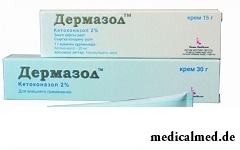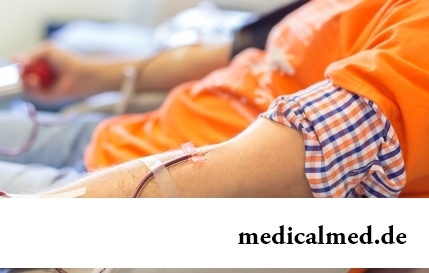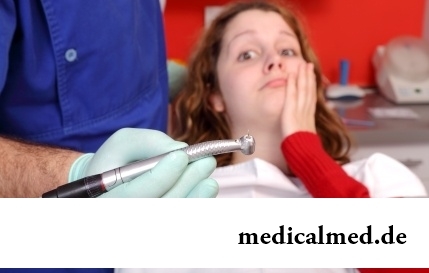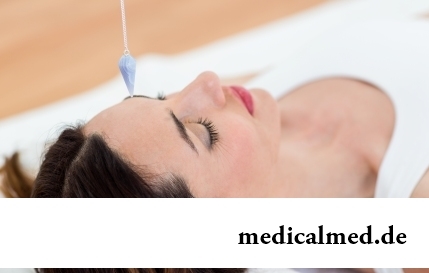





Dermazol
Application instruction:
 Dermazol – antifungal drug for external use, fungicidal and a fungistasis.
Dermazol – antifungal drug for external use, fungicidal and a fungistasis.
Form of release and structure
Dosage form – cream for external use of 2% (on 15 g or 30 g in aluminum tubas, in a cardboard pack 1 tuba).
Active ingredient – кетоконазол, in 1 g of cream of 20 mg.
Indications to use
Dermazol's use is shown:
- Outwardly: dermatomycosis of smooth skin; prevention and treatment of fungal infections of skin of a pilar part of the head; inguinal epidermophitia; skin candidiasis; epidermophitia of feet and brushes;
- Locally: treatment of chronic and acute recurrent vaginal candidiasis; prevention of fungal infections of a vagina at the lowered body resistance and at the antibacterial therapy by other means and drugs leading to disturbance of normal microflora of a vagina;
- Inside (in case of unavailability and intolerance of other methods of treatment): paracoccidioidomycosis, coccidioidomycosis, zymonematosis, chromomycosis, histoplasmosis.
Contraindications
- Chronic and acute forms of diseases of a liver;
- The expressed renal failures;
- Period of pregnancy and breastfeeding;
- Age up to 3 years;
- Concomitant use with the following substrates of an isoenzyme CYP3A4: various groups of cardiovascular drugs (ранолазин, ивабрадин); antiarrhytmic means (quinidine, Disopyramidum, дронедарон, дофетилид); blockers of calcium channels (нисолдипин, фелодипин, bepridit, лерканидипин); analgetics (methadone, левацетилметадол); anthelmintic and anti-protozoan means (галофантрин); gastrointestinal drugs (цизаприд, домперидон); antihistaminic drugs (мизоластин, астемизол, терфенадин); antineoplastic means (иринотекан); drugs for treatment of migraine (methylergometrine, ergometrine, dihydroergotamine, ergotamine); anxiolytics, antipsychotic and somnolent drugs (сертиндол, луразидон, Pimozidum, to triazoles, at oral administration midazolam); diuretics (эплеренон); hypolipidemic drugs (ловастатин, симвастатин); immunodepressants (эверолимус); other (colchicine). The combination of the listed drugs with ketokonazoly leads to increase in their concentration in a blood plasma that can lead to extension or increase in therapeutic and/or side effects, including to emergence of potentially dangerous effects, such as development of ventricular arrhythmia like "pirouette" and lengthening of an interval of QT (an electrical systole of heart);
- Hypersensitivity to a ketokonazol.
Route of administration and dosage
The dosing mode for external and topical administration depends on clinical indications and the used dosage form.
At purpose of drug inside, cream is accepted during food of 1 times days.
The recommended dose for intake:
- To adults and children weighing more than 30 kg – on 200-400 mg a day;
- To children weighing up to 30 kg – on 4-8 mg on 1 kg of body weight a day.
Side effects
- From the alimentary system: an abdominal pain, nausea, vomiting, diarrhea, functional disturbances of a liver, abdominal distention, dyspepsia, dryness in a mouth, language discoloration, a lock, a dysgeusia, toxic hepatitis (increase in activity of hepatic transaminases or the alkaline phosphatase (AP), jaundice, a liver failure, a heavy hepatotoxic, including cholestatic hepatitis, гепатонекроз (biopsy), cirrhosis (including cases of transplantation and death));
- From cardiovascular system: orthostatic hypotension;
- From a nervous system: drowsiness, the general weakness, dizziness, a headache, paresthesias, a hyperexcitability, alarm, sleeplessness, fatigue, reversible increase in intracranial pressure (swelling of a fontanel at children of younger age, hypostasis of disks of optic nerves);
- From a metabolism: increase in appetite, intolerance of alcohol, lipidemia, anorexia;
- From a musculoskeletal system: arthralgia, mialgiya;
- From skin and a hypodermic fatty tissue: itch, rash, alopecia, erythema, mnogoformny erythema, dermatitis, rushes of blood, xeroderma, photosensitization, acute generalized exanthematous пустулез;
- From respiratory system: nasal bleeding;
- From sense bodys: photophobia;
- From immune system: pseudoanaphylactic shock;
- From endocrine system: insufficiency of function of adrenal glands, a gynecomastia, disturbance of a menstrual cycle, decrease in level of concentration of testosterone in a blood plasma (in 24 h after reception it is normalized) is possible;
- From a reproductive system: impotence, an azoospermism (at doses it is higher than 200-400 mg in days);
- From laboratory indicators: decrease in number of thrombocytes in peripheral blood, thrombocytopenia;
- Allergic reactions: urticaria, rash, anaphylactic reactions, Quincke's disease, acute anaphylaxis;
- General reactions: fever, fever, peripheral hypostasis.
Special instructions
Dermazol's use at fungal meningitis as кетоконазол badly gets through a blood-brain barrier (GEB) is inexpedient.
Because of risk of a hepatotoxic, кетоконазол it is necessary to apply only if the expected potential advantage exceeds possible risk.
Before purpose of drug it is necessary to estimate a functional condition of a liver for an exception of chronic and acute diseases.
The patients who transferred toxic damage of a liver owing to use of other medicines or with a superactivity of liver enzymes should not accept кетоконазол, except those cases when the expected effect justifies risk of damage of a liver.
The total dose of drug is risk factor of a heavy hepatotoxic at patients which development cannot be excluded, since first week of treatment. Therefore not to pass the first symptoms of a hepatotoxic, use of drug needs to be accompanied with regular control of a picture of peripheral blood, a functional condition of kidneys and a liver.
At researches кетоконазол in a daily dose of 400 mg and more caused decrease in "the kortizolovy response" to stimulation of adrenocorticotropic hormone (AKTG) in volunteers. Therefore during use of drug it is necessary to control function of adrenal glands at patients with the diagnosed adrenal insufficiency or borderline cases owing to stressful influence, including conditions of an intensive care, extensive surgeries or patients with the long period have treatments at suspicion on adrenal insufficiency.
Dermazol appoint not earlier than a two-week break after cancellation of the previous therapy of skin diseases of glucocorticosteroids (GKS).
Absorbability of a ketokonazol increases the use of acid drinks.
Medicinal interaction
Simultaneous use with antiacid drugs (blockers of histamine H2 receptors, aluminum hydroxide, inhibitors of the protonew pump) reduces bioavailability of a ketokonazol. Decrease in absorption of drug in combination with powerful inductors of an isoenzyme CYP3A4, such as рифабутин, an isoniazid, rifampicin, эфавиренз, carbamazepine, Phenytoinum, not Virapinum is possible. These combinations demand regular control of antifungal activity of Dermazol, and in case of decrease in its efficiency – carrying out correction of its dose towards increase.
Antiviral drugs, CYP3A4 isoenzyme inhibitors, including ритонавир, strengthened ritonaviry фосампренавир and дарунавир, can increase drug absorption. In this case it is recommended to control a condition of the patient for definition of signs of increase in activity and duration of effect of drug, if necessary to carry out decrease in its dose on the basis of data on concentration of a ketokonazol to blood.
Ketokonazol is capable to slow down the mediated metabolism of inhibitors of an isoenzyme of CYP3A4 and the movement of active agents caused by a P-glycoprotein. It can cause increase in level of concentration of these drugs and/or their active metabolites in a blood plasma and to become the reason of increase in duration and intensity of therapeutic or side effects of the medicines used in a combination.
It is not recommended to apply кетоконазол along with fentanyl, tamsuloziny, rifabutiny, carbamazepine, rivaroksabany, trabektediny, dazatiniby, nilotiniby, salmeteroly. At impossibility to avoid these combinations, it is necessary to provide clinical control of a condition of the patient, level of concentration of the corresponding drug in plasma, and if necessary to reduce a dose or to cancel its reception.
With care it is recommended to combine use of a ketokonazol with the following medicines: аторвастатин, periwinkle alkaloids, alfentanil, алитретиноин (for intake), алискирен, to alprazola, the aprepitant, арипипразол, buprenorphine (intravenously (in/in) and it is sublingual), brotiozolam, бортезомиб, буспирон, бусульфан, будесонид, verapamil, a haloperidol, dexamethasone, digoxin, dotsetakset, иматиниб, индинавир, иксабепилон, имидафенацин, coumarins, кветиапин, лапатиниб, a maravirok, midazolam (in/in), Methylprednisolonum, мозаваптан, Nadololum, oxycodone, a praziquantel, пероспирон, рамелтерон, ребоксетин, репаглинид, рисперидон, саксаглиптин, sildenafit, солифенацин, саквинавир, сиролимус, триметрексат, такролимус, tadalfit, темсиролимус, толтеродин, толваптан, эрлотиниб, tsinakaltst, циклесонид, цилостазол, cyclosporine, флутиказон, фезотеродин, эбастин, элетриптан. At a concomitant use it is regularly necessary to monitor a clinical condition of the patient, in case of need to control concentration of drug in a blood plasma and if it is required – to lower its dose.
Alcohol intake during treatment ketokonazoly in isolated cases can cause disulfiramopodobny reaction.
Terms and storage conditions
To store in the dry, protected from light place at a temperature up to 25 °C. To protect from children.
Period of validity – 3 years.
Having fallen from a donkey, you more likely will kill yourself, than having fallen from a horse. Only do not try to disprove this statement.

To look healthy and means well-groomed not only to be pleasant to people around, but also to feel strong, sure and taken place. To Spa...
Section: Articles about health
All got used long ago that, having addressed the plastic surgeon, it is possible to modify natural parameters of a figure or to minimize the damages put to appearance with ruthless time. Many people (preferential women) worldwide е...
Section: Articles about health
The way of life of people promptly changes from year to year: if about ten years ago the personal computer was not in each family, then today already very few people do without this device. Certainly, and children master the computer at full speed: they not only play on it games, but also study, and write school works, and search for necessary information....
Section: Articles about health
It is known that the person for 80% consists of water which participates in all processes of an organism. The person loses liquid daily – in...
Section: Articles about health
Household skills which to us so diligently imparted in the childhood it appears, not always bring only benefit. According to results of the last researches, some habits which for a long time were considered useful and even necessary can become...
Section: Articles about health
For many spouses the question of planning of a family is one of the main. The problem of the choice of effective and safe contraceptives at the same time comes out on top. Russians still not often resort to operation of a vasectomy extremely popular in the USA, and also in some European and Asian countries. The reason is simple: most of men simply do not possess the complete information about specifics and effects of this procedure. Let's try to meet this lack and to acquaint readers about those...
Section: Articles about health
Reactive pancreatitis - the disease which is characterized by inflammatory process in a pancreas which arises more often everything...
Section: Articles about health
Transfusion of donor blood has almost century history. In spite of the fact that this procedure is quite usual for many people, process of blood donation is still surrounded with numerous myths. Today we aimed to discredit the most widespread of them....
Section: Articles about health
It is pleasant to state a possibility of improvement of quality of life of people with problems of functioning of secretory system. Efforts of talented inventors created products which will be able to provide normal life activity of clients with moderate degree of a disease, it is essential to facilitate the help to patients with strongly expressed disturbances....
Section: Articles about health
EKO, or extracorporal fertilization - a method of treatment of infertility which became the reason of a set broken mines in due time...
Section: Articles about health
Statistically, can only one of ten of our compatriots brag of a decent condition of an oral cavity. Six teeth affected with caries are the share of the average Russian. For comparison, this indicator for Europeans almost six times exchanges...
Section: Articles about health
The trophic ulcer is not an independent disease. This heavy complication arising owing to a thermal injury (a burn or a frostbite), chronic pathologies of arteries or veins of the lower extremities, a diabetes mellitus, and also some defeats of connecting fabric, absorbent vessels, skin or nervous trunks. Pathology is shown in the form of not healing wound located on the internal surface of a shin, a foot sole, a heel or toes....
Section: Articles about health
The depression not without reason is considered one their main troubles of our century: for scientific and technical progress, acceleration of rate of life and a surplus...
Section: Articles about health
Good appetite was always considered as a sign of good health. The correct operation of the mechanism which is responsible for the need for nutrients and receiving pleasure from process of its satisfaction demonstrates that the organism functions without special from...
Section: Articles about health
For the last decades the diabetes mellitus of the second type became really world problem. The number of cases annually increases, and average age of patients for whom the illness is diagnosed, steadily decreases. Specialists consider that one of the main reasons for this trouble is disturbance of a diet. In other words, the huge number of people regularly overeats or excessively is fond of the products causing glucose exchange process failures....
Section: Articles about health
Physical activity is necessary for normal functioning of a human body. At a lack of the movement cease функц...
Section: Articles about health
You heard that laughter prolongs life? Researchers did not manage to establish longevity direct link with sincere fun yet, but several facts confirming beneficial influence of risibility on the state of health are clinically proved....
Section: Articles about health
Beauty shop – the place which is associated only with positive emotions: joy, pleasure, relaxation. However visit of salon where work with biological material of clients, not always harmlessly is conducted. Today more than 100 pathogenic microorganisms who can catch in beauty shop including deadly to health are known....
Section: Articles about health
The problem of diagnosis was and remains to one of the most important in medicine. From that, the reason недо will be how precisely defined...
Section: Articles about health
Practice of hypnotic impact on consciousness of the person contains about two millennia. During this time scientists managed to learn a lot of things about a phenomenon of hypnosis and learned to facilitate a condition of the patients having heavy illnesses with its help....
Section: Articles about health
Practically each person is familiar with the annoying, pulling, unscrewing pains caused by overcooling of muscles of a back. In certain cases inflammatory process is not limited to discomfort, being followed by emergence of hypostasis, consolidations, temperature increase. At the wrong treatment the acute miositis can lead to a chronic disease or aggravation of other pathologies of a back (vertebral hernia, osteochondrosis) therefore it is important to pay attention to symptoms of an illness in time and to start to...
Section: Articles about health
Heart disease and blood vessels lead to disturbance of blood supply of bodies and fabrics that involves failures in their works...
Section: Articles about health
Life of the modern child is extremely active and difficult. Information strain which is experienced by the school student and did not dream pupils of last times. Careful parents, wishing well to the children, will organize a set of additional classes in circles, sports...
Section: Articles about health
Each of us faces from time to time that other people need the immediate help. We react to it differently: one at once call doctors and police, others rush to victims and try to save them independently. Some pass by at all … Certainly, desire to help the neighbor who got into trouble, quite naturally for any decent person. However not everyone understands that to work in a similar situation, being guided by exclusively good...
Section: Articles about health
The phenomenon of improvement of a condition of the patients at administration of drugs who are not containing active agents, so-called effect of placebo is known...
Section: Articles about health
It is impossible to imagine human life in which there would be no plants. Practically in each apartment and any production room there are window plants, millions of people with pleasure are engaged in gardening and truck farming, many citizens пр...
Section: Articles about health
We live during an advertizing era. Daily each person receives a solid portion of persuasive councils about what to eat to be healthy and successful. Products about which we will talk today are combined by the following circumstance: all of them are positioned as the most useful and the most suitable for inclusion in a morning meal. Unfortunately, it is not true: these 10 products do not suit for breakfasts at all....
Section: Articles about health
